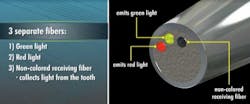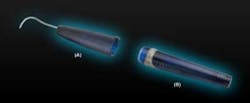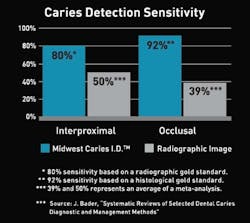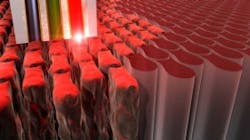Early caries detection
By Cindy Sensabaugh, RDH, BS, Manager, Clinical Research & Education, DENTSPLY Professional
The introduction of innovative technologies has expanded the opportunities to practice early intervention of demineralized lesions. Adjunctive detection methods available to dental practitioners include Red-infrared reflectance technology commercially available as the Midwest Caries I.D. www.cariesid.com.
This hand-held device uses infrared and red light-emitting diodes (LED) and fiber optics to distribute light to the tooth structure. This technology detects mineral loss in enamel by measuring the light reflectance and refraction difference of infrared light on decalcified enamel as compared to healthy enamel. The device helps detect demineralized lesions earlier in the process, allowing for more conservative treatment.
Infrared light travels into the enamel as if it were relatively transparent. When the light hits demineralized enamel, it is scattered and attenuated, a detection fiber optic collects light from the examined area and sends that light to a photo-detector that measures returned collected light. This photo-detector then transmits the signal to a microprocessor that compares signal levels with defined parameters. When healthy tooth substance is detected, the green LED stays on resulting in a non-red color illuminating the tooth. When demineralization is detected, the processor deactivates the third LED (green), illuminating only the red LED, and pulses at a higher intensity. The lesion is identified by an audible tone, and a visual signal (red or non- red) on the tooth. The intensity or speed of the beep is proportional to the extent of demineralization. This device should be used on a wet surface to achieve reliable, accurate detection of the earliest stages of enamel demineralization.
As with any clinical technique for diagnosis, the diagnosis should not be made based on a single parameter. Rather the diagnosis is based on the all the available supporting evidence and the clinician's clinical skill and judgment.(1) Incorporating adjunctive detection technologies into clinical practice facilitates the earlier identification of non-cavitated lesions, thus providing the clinician with an increased opportunity to reverse or arrest the demineralization process.References
1. Strassler, HE. Technology enhanced caries detection and diagnosis. Compend Contin Educ Dent 2008; 29(8): 464-5, 468,470.
1. Strassler, HE. Technology enhanced caries detection and diagnosis. Compend Contin Educ Dent 2008; 29(8): 464-5, 468,470.
Cindy Sensabaugh, RDH, BS





